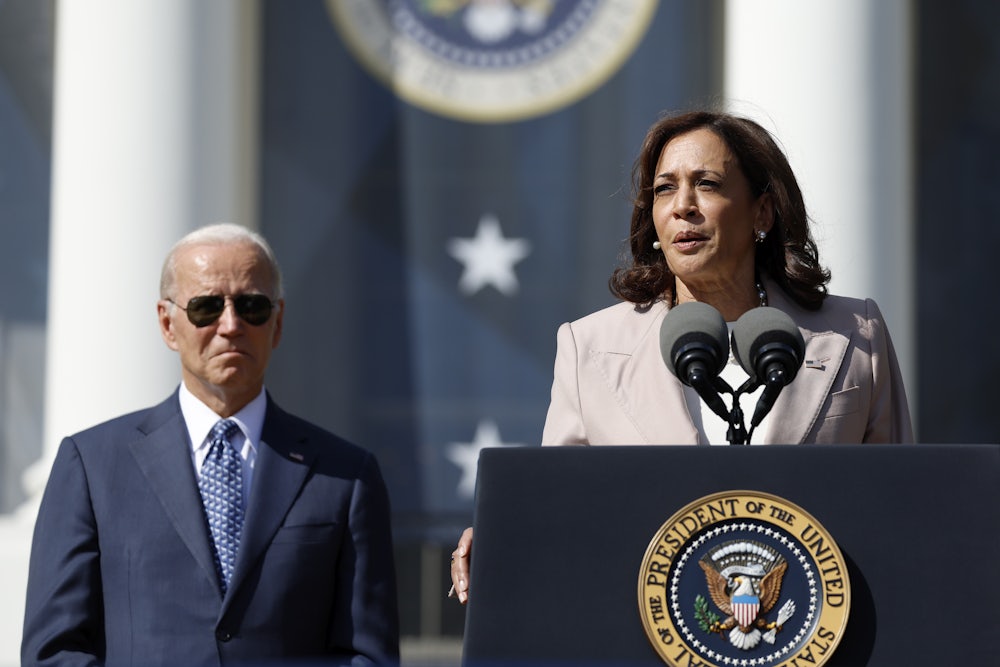This week marks two years since Congress passed the Inflation Reduction Act, arguably the Biden administration’s signature legislative achievement. So how’s it doing? A lot better than recent headlines would have you believe. As the November election draws nearer, however, Vice President Kamala Harris and her team will have to confront some lingering questions about the policy’s strengths and weaknesses.
On Monday, the Financial Times published an investigation finding that 40 percent of the largest manufacturing announcements made since Congress passed the Inflation Reduction Act and CHIPS and Science Act—which together invested some $400 billion in building up domestic clean energy and semiconductor industries—have been delayed.* “The delays raise questions around Biden’s bet that an industrial transformation can deliver jobs and economic returns to the U.S.,” the investigation’s authors write.
The other way of reading that data, of course, is that 60 percent of projects are on track. “It was surprising that there weren’t more delays,” says Jonas Nahm, an associate professor at Johns Hopkins School of Advanced International Studies, whose research focuses on green industrial policy in the United States, Europe, and China. Nahm, who until recently served as a senior economist on the White House–based Council of Economic Advisers, notes that manufacturing construction spending is up 130 percent, adjusted for inflation. In that context, he told me, “you can imagine there is a limited amount of resources to go around and competition for what’s needed.”
Manufacturing projects can hit any number of snags between when they’re announced and when construction and production actually start. Most siting for plants happens at the local level, and a burst of investment nationwide can mean that prime sites preselected by development authorities—those that have already navigated the necessary regulatory processes—can get used up quickly. Companies might then need to start their search and approval processes over again. Depending on where sites are and the types of manufacturing slated to happen there, they might have difficulty finding workers. Increased demand for resources like steel and cement can drive up costs, as well. In the case of the IRA and the CHIPS and Science Act, all that work has also taken place amid rising interest rates. Industries are still waiting for the Treasury Department to finalize the last rules around which projects are eligible for IRA tax incentives, creating some amount of uncertainty for investors.
For those who study industrial policy—essentially, government-led investment to drive private-sector investment in strategic export sectors—these sorts of growing pains aren’t all that unusual. “When it comes to state capacity, the agencies and capabilities and staff and knowledge to organize and coordinate these things, most democracies are probably underprepared for their industrial policy visions,” says Nathan Lane, associate professor in economics at University of Oxford and co-founder of the Industrial Policy Group, which focuses on empirical evaluations of industrial policies. “People act as if the states that do this stuff drop from the sky and are capable and able to do these things. But you have to build as you go,” Lane added, referencing South Korea’s and Japan’s yearslong quests to get industrial policies off the ground decades ago.
That these problems are common doesn’t mean they’re easy to surmount. Of the $1.1 trillion in federal infrastructure and pandemic relief spending passed through Congress since Biden took office, just $125 billion had gone out the door as of this past April. That’s per a lengthy Politico analysis of the American Rescue Plan, the bipartisan infrastructure law, the CHIPS and Science Act, and the IRA. As that story notes, the government provides very little centralized data on how much of that money has actually been spent.
To the extent that the IRA is faltering, much of that is due to the political wrangling that was needed to pass it to begin with—and, relatedly, to the bill’s hands-off approach in letting corporations (primarily) get things done. To refresh: The IRA was passed through a process known as budget reconciliation. Because Democrats knew they wouldn’t be able to count on getting any Republicans to vote for a climate-friendly suite of tax incentives, reconciliation allowed them to pass a major spending package with their slim majority and avoid a GOP filibuster. That also meant that everything in it had to be packaged as a spending measure; the IRA does not, that is, set emissions-reductions targets but instead uses federal funds to spur investments in targeted sectors, chiefly zero-carbon electricity and green manufacturing.
Broadly speaking, IRA monies are divided into a couple of different buckets. The bulk of its $394 billion in energy and climate funding is dispersed through tax credits, with additional funds provided via loans and grants. McKinsey estimates that $43 billion of those tax credits are directed toward consumers through discounts on clean energy and energy-efficiency upgrades. Recently released data on the IRA finds that 3.4 million Americans have claimed $8 billion worth of consumer-side tax credits to install things like heat pumps and solar panels. Wealthier filers, though, who are better able to afford the still considerable cost of such upgrades, were much more likely to take advantage of those discounts. Renters are also generally excluded from using those incentives.
The majority ($216 billion) of IRA tax credits are expected to flow toward corporations. States and local governments, as well as tribal entities and institutions such as rural electric cooperatives, can take advantage of IRA funds too, and it notably expanded renewable energy tax credits, which had previously excluded virtually everyone except very large companies. Arriving at precise numbers on how much IRA tax incentives are worth is tough, though, since they’re “uncapped,” meaning there’s no finite pool of cash. All of those programs are set to expire in 2032, after which Congress would need to renew them.
How and whether that money is spent is contingent on an uneven patchwork of institutions and idiosyncratic local economic development bureaucracies. Southern states that have long tried to court foreign direct investment have been better equipped to attract green manufacturing projects. Georgia, for instance, has seen 32 new clean energy projects worth $15 billion in new investment announced since the IRA passed; North Carolina has 22 such projects, worth $22 billion, according to a tracker maintained by the clean energy lobby group E2. Similarly, states with established green banks or infrastructure banks, which are more common in blue states, have more capacity to handle federal funds for clean electricity projects. And because many of the country’s more recent economic development initiatives have been focused at the local level, on bodies like community development financial institutions, spending money at a larger scale can be a challenge if there isn’t preexisting infrastructure in place.
The Center for Public Enterprise, or CPE, is part of a small ecosystem of groups looking to provide technical assistance for state-level public entities to take advantage of IRA funds. “There’s all this money flowing into CDFIs, state green banks, and community developers. Now all of them who are interested in building renewable energy capacity outside the private sector are coming to the realization that they face the same barriers as the private sector,” says Advait Arun, CPE’s senior associate for energy finance. “A lot of local lenders have never really touched energy, which involves its own kinds of risks and financial modeling and technical issues. Procurement is another issue. Centralizing all that knowledge and capacity is going to be really necessary.”
Even wealthy states with Democratic supermajorities have had trouble making full use of the IRA so far. After a lengthy organizing drive, the New York legislature last year mandated that the state-run New York Power Authority, or NYPA, work to help meet the state’s climate goals by building publicly owned renewable energy; NYPA’s newfound ability to access IRA-furnished tax credits to do so was a key factor in public power advocates’ ability to push the measure over the finish line, as campaigners argued that the New Deal–era public power provider would be leaving money on the table. More than a year on from its passage, the state has leaned heavily on McKinsey to implement the Build Public Renewables Act, and faces lingering uncertainties over where to build generation and how to connect it to the grid, a process controlled by the New York Independent System Operator, or NYISO. Public entities like NYPA also have to meet more stringent domestic content requirements in order to qualify for IRA benefits.
Public entities should in theory be better equipped to meet public policy priorities than companies that are only accountable to their shareholders. Even the relatively modest goals of the IRA, though—encouraging as much predominantly private investment in low- and zero-carbon technologies as possible—could prove difficult without higher-level planning to sort out coordination problems like those playing out in New York. “When we entrust so much of the green industrialization process to actors that have never really been coordinated before, there’s going to be a lot of stumbling blocks,” Arun tells me.
The future of the IRA could depend heavily on what happens in November. White House officials seem confident that its incentives will be difficult to peel back, however loudly Trump and the GOP are pledging to ditch the “Green New Scam,” as vice presidential candidate J.D. Vance has been calling the IRA. A small number of House Republicans have tried to warn their colleagues against repealing the legislation. Indeed, the vast majority of the investments are flowing to red states. Per E2, 201 projects worth $106 billion are housed in congressional districts that are represented by Republicans. There are 115 projects in congressional districts represented by Democrats, worth just $16 billion. “Prematurely repealing energy tax credits, particularly those which were used to justify investments that already broke ground, would undermine private investments and stop development that is already ongoing,” 18 congressmen wrote in a letter to House Speaker Mike Johnson. “A full repeal would create a worst-case scenario where we would have spent billions of taxpayer dollars and received next to nothing in return.” Still, as the GOP’s costly crusades against the specter of environmental, social, and governance–related, or ESG, investment factors has shown, the party isn’t always driven by economic logic.
It’s probably too early to tell how much daylight there will be between Biden and Harris on questions of industrial policy, although she’s recently brought on Obama and Blackrock alum Brian Deese—a lead architect of the IRA—as a top adviser.
On its own terms, the IRA has been a success, driving investments in important technologies that wouldn’t have happened otherwise. But Harris and her team will have to grapple with other questions as they navigate their approach to green industrial policy on the campaign trail and beyond.
First, does anyone care about the IRA’s successes? Polling published this spring by the Associated Press and NORC Center for Public Affairs Research found that about a quarter of Americans say IRA-furnished tax credits haven’t made a difference in their lives, while nearly 40 percent reported not knowing enough about those measures to have an opinion. Similarly, Politico-Morning Consult polling conducted in late April found that 17 percent of registered voters had heard “a lot” about the IRA, while 35 percent had heard “some” about it—better name recognition than the American Rescue Plan, Bipartisan Infrastructure Law, and CHIPS and Science Act. More than half (52 percent) of all registered voters reported that the IRA has impacted them negatively or not at all, or that they didn’t know.
Perhaps the larger problem from a climate perspective is that the IRA was written mainly to create globally competitive green export sectors, not to reduce emissions economy-wide. To invoke one of Kamala Harris’s favorite explanatory tools, the center of the Venn diagram between those two goals is only so big. If the Inflation Reduction Act was the best climate policy that could have passed in 2022—and it probably was—then what is it doing to whet voters’ appetite for the more sweeping changes that decarbonization requires?
* This piece originally misstated the total amount of money the Inflation Reduction Act and CHIPS and Science Act invested in clean energy development.








